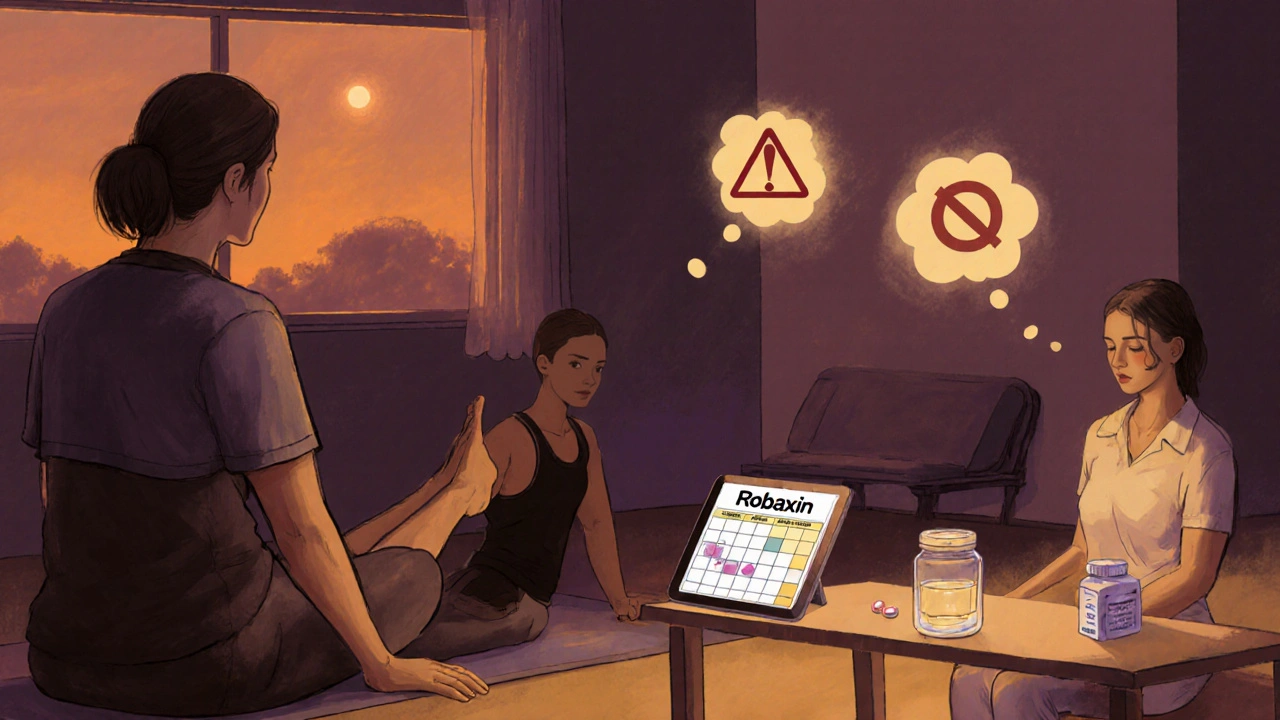Muscle Relaxant Selector
Recommended Option
Why This Recommendation?
Key Takeaways
- Robaxin (Methocarbamol) works by relaxing muscle spasms without strong sedation, making it a good first‑line option for acute back or neck pain.
- Faster‑acting alternatives like cyclobenzaprine start relief in 30‑60 minutes but often cause drowsiness.
- Long‑acting agents such as baclofen are better for chronic spastic conditions rather than short‑term injury‑related pain.
- Non‑opioid NSAIDs (e.g., ibuprofen) treat inflammation directly and can be combined with a mild relaxant for synergistic effect.
- Cost, drug interactions, and personal tolerance to side‑effects usually decide which option fits best.
What Is Robaxin (Methocarbamol)?
When building a treatment plan for muscle strain, the first question is often "which medication will calm the spasm without knocking me out?" Robaxin is a brand name for methocarbamol, a centrally acting muscle relaxant that reduces skeletal muscle hyperactivity. It was first approved by the FDA in 1957 and has been used worldwide for acute musculoskeletal injuries, low‑back pain, and neck stiffness.
Unlike classic sedatives, methocarbamol does not directly bind to GABA receptors; instead, it interferes with neuronal pathways that trigger involuntary muscle contractions. The result is a noticeable decrease in pain and increased range of motion, usually within 1-2 hours after the first dose.
How Does Robaxin Work and When Is It Used?
Robaxin is typically prescribed for short‑term relief (5‑7days) after a sudden injury - think a pulled hamstring from a weekend soccer match or a whiplash episode from a minor car collision. The usual adult dose is 1500mg four times daily for the first 48hours, then tapered to 1000mg three times daily.
Because it does not have strong analgesic properties, doctors often pair it with an NSAID (e.g., ibuprofen) or acetaminophen to cover both the inflammatory and spasm components of pain.
Core Criteria for Choosing a Muscle Relaxant
Before we jump into the side‑by‑side table, keep these decision points in mind. They reflect what patients and clinicians weigh when swapping one drug for another.
- Efficacy for the specific condition - acute strain vs. chronic spasticity.
- Onset of action - how quickly you feel relief.
- Duration of effect - number of hours the drug covers you.
- Side‑effect profile - drowsiness, dizziness, hypertension, etc.
- Drug‑interaction risk - especially with anticoagulants, antihypertensives, or other CNS depressants.
- Cost and insurance coverage - average price per 30‑tablet pack in Australia.
- Availability - prescription‑only vs. over‑the‑counter alternatives.
Comparison Table - Robaxin and Popular Alternatives
| Drug (Generic) | Drug Class | Typical Adult Dose | Onset | Duration | Common Side‑effects | Typical Cost (AU$ per 30‑tablet pack) |
|---|---|---|---|---|---|---|
| Methocarbamol | Central muscle relaxant | 1500mg q4h (first 48h), then 1000mg TID | 1-2h | 4-6h | Drowsiness (rare), GI upset | AU$25‑30 |
| Cyclobenzaprine | Tricyclic‑derived relaxant | 5‑10mg TID | 30‑60min | 6-8h | Drowsiness, dry mouth, constipation | AU$20‑25 |
| Baclofen | GABA‑B agonist | 5‑10mg TID (titrate up to 30mg TID) | 1-2h | 4-6h | Weakness, dizziness, hypotension | AU$18‑22 |
| Tizanidine | α‑2 adrenergic agonist | 2‑4mg TID (max 12mg/day) | 30‑60min | 3-4h | Dry mouth, mild liver enzyme rise | AU$28‑35 |
| Ibuprofen (NSAID) | Non‑steroidal anti‑inflammatory | 400‑800mg Q6‑8h | 15‑30min | 4-6h | GI irritation, renal impact (high dose) | AU$10‑12 |
When to Choose Robaxin Over Other Options
If you need a muscle relaxant that doesn’t make you feel drowsy enough to miss a meeting, methocarbamol is often the sweet spot. It’s particularly useful for:
- Acute low‑back or neck strain where sedation would hinder early mobilization.
- Patients already on antihistamines or other sedating meds - the additive sleepy effect is minimal.
- Situations where a rapid dose‑escalation (1500mg) is needed for severe spasms but you still want to taper quickly.
Because its side‑effect list is shorter compared to cyclobenzaprine, many clinicians keep a small pack of Robaxin in the office for sports‑injury clinics.

Best Scenarios for the Alternatives
Cyclobenzaprine shines when you need quicker relief and can tolerate mild sedation. It’s a go‑to for overnight pain because the drowsiness can actually aid sleep.
Baclofen is the champion for chronic spasticity, such as that seen in multiple sclerosis or spinal cord injury. Its muscle‑weakening effect can be a drawback for acute injury rehab, but it’s invaluable for long‑term tone control.
Tizanidine works well for patients who have hypertension or who need a short half‑life drug that wears off before driving. Liver‑function monitoring is required, however.
When inflammation is a major driver (e.g., a sprained ankle), ibuprofen or another NSAID often provides more direct pain relief than a pure relaxant. Combining a low‑dose relaxant with an NSAID can cover both pathways without escalating side‑effects.
Safety Considerations and Contra‑indications
All muscle relaxants share a few red flags. Never combine them with alcohol, benzodiazepines, or opioid analgesics unless a physician explicitly approves - the risk of respiratory depression goes up sharply.
Specific cautions:
- Robaxin: Avoid in patients with severe hepatic impairment; monitor liver enzymes if therapy exceeds two weeks.
- Cyclobenzaprine: Contra‑indicated in uncontrolled narrow‑angle glaucoma and recent myocardial infarction due to its tricyclic structure.
- Baclofen: Use with care in people with renal dysfunction; abrupt cessation can cause withdrawal seizures.
- Tizanidine: Not suitable for severe hepatic disease; dose‑adjust in the elderly.
- Ibuprofen: Avoid in peptic ulcer disease, advanced kidney disease, or in the third trimester of pregnancy.
Practical Tips for Patients
- Take the first dose with food to reduce stomach upset, especially for NSAIDs.
- Space doses at least 4hours apart; don’t double up if you miss a pill.
- Stay hydrated - dehydration can amplify dizziness.
- Combine medication with gentle stretching or physiotherapy after the first 24hours; early movement prevents stiffness.
- Keep a medication diary - note the time of relief, any side‑effects, and overall pain scores. This data helps your doctor fine‑tune the regimen.
Frequently Asked Questions
Can I take Robaxin and ibuprofen together?
Yes, most doctors prescribe methocarbamol alongside an NSAID because they act on different pain pathways. Take the ibuprofen with food and stagger the doses (e.g., ibuprofen every 6h, methocarbamol every 4h) to spread out stomach exposure.
How long should I stay on Robaxin?
Most guidelines recommend a maximum of 7‑10days for acute muscle spasm. If pain persists beyond two weeks, see your doctor for a reassessment - the underlying issue may need a different approach.
Is cyclobenzaprine stronger than methocarbamol?
"Stronger" depends on the metric. Cyclobenzaprine works faster and often feels more potent because it induces mild sedation, which masks pain. Methocarbamol provides clearer mental alertness but may need a higher dose for the same spasm relief.
What are the risks of long‑term baclofen use?
Long‑term baclofen can cause muscle weakness, dependence, and rare withdrawal seizures if stopped abruptly. Regular liver and kidney function tests are advised, especially in patients over 65.
Are there natural alternatives to prescription muscle relaxants?
Heat therapy, magnesium supplementation, and gentle yoga can reduce muscle tension without medication. For mild spasms, these approaches often work as well as low‑dose NSAIDs, especially when combined with proper stretching.
Choosing the right muscle relaxant is less about "which drug is the best" and more about matching the drug’s profile to your specific injury, lifestyle, and health background. Use the table, weigh the criteria, and talk openly with your prescriber - the right choice will get you moving faster and keep side‑effects in check.


Scott Swanson
October 9, 2025 AT 14:03Oh sure, because the only thing stopping me from being productive is a little muscle relaxant.
Karen Gizelle
October 20, 2025 AT 00:03Picking a drug should never be reduced to a cheap convenince. People have a responsibility to consider sedation risks, especially when operating heavy machinery. It's ethically unacceptable to jeopardize others for a fleeting pain relief. You must read the label and understand the side‑effects.
Stephanie Watkins
October 29, 2025 AT 20:09The onset time for methocarbamol typically ranges from one to two hours, which aligns with the pharmacokinetic data presented earlier. For acute strains, this window often balances timely relief with minimal sedation.
Zachary Endres
November 8, 2025 AT 02:23Give your muscles a break without falling asleep at your desk! Robaxin hits that sweet spot-fast enough to notice, gentle enough to stay alert. Pair it with some light stretching and you’ll be back to your routine in no time. Remember, mobility wins over stubborn stiffness.
Ashley Stauber
November 17, 2025 AT 03:03Everyone loves cyclobenzaprine for its quick knock‑out effect, but the drowsiness can be a hidden trap for drivers. If you’re looking for a drug that lets you stay upright, methocarbamol actually outperforms many of its peers. The market hype often ignores this nuance.
Amy Elder
November 25, 2025 AT 22:09True, staying sharp matters; a low‑dose relaxer plus NSAID often does the job.
Erin Devlin
December 4, 2025 AT 14:29In the balance between pain suppression and consciousness, methocarbamol embodies a measured compromise.